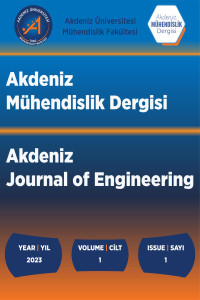Öz
Kinetik modellemede kullanılan n’inci dereceden (n-derece) model ile başka bir ampirik model birincil model olarak daha önce yayımlanmış α-laktalbumin’in farklı sıcaklıklardaki (67.5, 70, 72.5, 75, 77.5 ve 80°C) denatürasyonunu tanımlamak için kullanılmış ve karşılaştırılmıştır. Modellerin uygulamasından birinci dereceden kinetik modelin bu verileri tanımlamak için kullanılamayacağı ya da bu veriler için yetersiz kalacağı anlaşılmıştır. Az farkla da olsa beş sıcaklıkta n-derece model daha iyi uyum göstermiş, ampirik model ise sadece bir sıcaklıkta daha iyi sonuç vermiştir. Her iki modelin de birer parametresi sıcaklığa bağlı olarak değişmediğinden bu parametreleri altı sıcaklığın ortalaması olarak sabitlemek ve modelleri sadeleştirmek ya da indirgemek mümkündür. Benzer şekilde indirgenmiş n-derece model dört sıcaklık değerinde daha iyi sonuçlar vermiş, ampirik model iki sıcaklıkta daha iyi uyum göstermiştir. İndirgenmiş modellerde yer alan tek parametrenin de sıcaklıkla doğrusal olarak değiştiği görülmüş ve ikincil modelleme basit doğrusal regresyon kullanılarak yapılmıştır. İkincil modeller birincil (indirgenmiş) modeller içerisine yerleştirilerek üç farklı sıcaklıkta tahmin çalışması yapılmıştır. Her ne kadar 68°C’de iki modelin tahmini farklı çıkmış olsa da 74 ve 76.5°C’lerde iki model de hemen hemen aynı tahmini vermiştir. Sonuç olarak kinetik modelleme amacıyla bu veri setleri için her iki modelin de kullanılabileceği ancak farklı veri setleri için farklı sonuçlar elde edilmesinin mümkün olabileceği değerlendirilmiştir.
Anahtar Kelimeler
Bozunma Kinetiği Kinetik Modelleme Model Tahmini Model Uyumu Regresyon
Etik Beyan
N/A
Destekleyen Kurum
N/A
Teşekkür
N/A
Kaynakça
- [1] M.A.J.S. van Boekel, Kinetics of heat-induced changes in dairy products: Developments in data analysis and modelling techniques, International Dairy Journal 126, 105187, 2022.
- [2] M.A.J.S. van Boekel, Kinetics of heat-induced changes in foods: A workflow proposal. Journal of Food Engineering 306, 110634, 2021.
- [3] S.M. Loveday, β-Lactoglobulin heat denaturation: A critical assessment of kinetic modelling, International Dairy Journal 52, 92-100, 2016.
- [4] F.J. Jaskulka, D.E. Smith, K. Larntz, Determining the kinetic reaction rate order for the thermal denaturation of β-lactoglobulin using two statistical approaches. International Dairy Journal 10, 589-595, 2000.
- [5] A. Halabi, A. Deglaire, P. Hamon, S. Bouhallab, D. Dupont, T. Croguennec, Kinetics of heat-induced denaturation of proteins in model infant milk formulas as a function of whey protein composition. Food Chemistry 302, 125296, 2020.
- [6] M., Peleg, M.D. Normand, M.G. Corradini, A New Look at Kinetics in Relation to Food Storage. The Annual Review of Food Science and Technology 28, 135-153, 2017.
- [7] S. Buzrul, A predictive model for high-pressure carbon dioxide inactivation of microorganisms. Journal of Food Safety 29, 208-223, 2009.
- [8] C. Leylak, M. Yurdakul, S. Buzrul, Gıda bilimlerinde Excel kullanımı 1: Doğrusal regresyon. Food and Health 6, 186-198, 2020.
- [9] M., Peleg, M.D. Normand, M.G. Corradini, The Arrhenius equation revisited. Critical Reviews in Food Science and Nutrition, 52, 830-851, 2012.
Öz
The nth-order model commonly used in kinetic modeling and an empirical model were used to describe previously published denaturation of α-lactalbumin at different temperatures (67.5, 70, 72.5, 75, 77.5 and 80°C) as the primary models and a comparison was made. Application of the models revealed that the first-order kinetic model could not be used to describe these data i.e., the first-order kinetic model would be inadequate. The nth-order model produced slightly better fits at five temperatures, while the empirical model had better result at only one temperature. Since one parameter of each model did not depend on temperature, it was possible to fix these parameters by using the average values of six temperatures, and hence reduce the models. The reduced nth-order model had better results at four temperatures, whereas the empirical model produced better fits at two temperatures. It was observed that the sole parameter in the reduced models changed linearly with temperature, and secondary modeling was performed by simple linear regression. Secondary models were integrated into the primary (reduced) models and predictions were made at three different temperatures. Although the predictions of the two models were different at 68°C, the models had almost the same predictions at 74 and 76.5°C. It was concluded that both models can be used to describe the data for kinetic modeling purposes; however, outcomes may be different for other data sets.
Anahtar Kelimeler
Denaturation Kinetics Kinetic Modeling Model Fitting Model Prediction Regression
Kaynakça
- [1] M.A.J.S. van Boekel, Kinetics of heat-induced changes in dairy products: Developments in data analysis and modelling techniques, International Dairy Journal 126, 105187, 2022.
- [2] M.A.J.S. van Boekel, Kinetics of heat-induced changes in foods: A workflow proposal. Journal of Food Engineering 306, 110634, 2021.
- [3] S.M. Loveday, β-Lactoglobulin heat denaturation: A critical assessment of kinetic modelling, International Dairy Journal 52, 92-100, 2016.
- [4] F.J. Jaskulka, D.E. Smith, K. Larntz, Determining the kinetic reaction rate order for the thermal denaturation of β-lactoglobulin using two statistical approaches. International Dairy Journal 10, 589-595, 2000.
- [5] A. Halabi, A. Deglaire, P. Hamon, S. Bouhallab, D. Dupont, T. Croguennec, Kinetics of heat-induced denaturation of proteins in model infant milk formulas as a function of whey protein composition. Food Chemistry 302, 125296, 2020.
- [6] M., Peleg, M.D. Normand, M.G. Corradini, A New Look at Kinetics in Relation to Food Storage. The Annual Review of Food Science and Technology 28, 135-153, 2017.
- [7] S. Buzrul, A predictive model for high-pressure carbon dioxide inactivation of microorganisms. Journal of Food Safety 29, 208-223, 2009.
- [8] C. Leylak, M. Yurdakul, S. Buzrul, Gıda bilimlerinde Excel kullanımı 1: Doğrusal regresyon. Food and Health 6, 186-198, 2020.
- [9] M., Peleg, M.D. Normand, M.G. Corradini, The Arrhenius equation revisited. Critical Reviews in Food Science and Nutrition, 52, 830-851, 2012.
Ayrıntılar
| Birincil Dil | Türkçe |
|---|---|
| Konular | Gıda Mühendisliği |
| Bölüm | Araştırma Makalesi |
| Yazarlar | |
| Yayımlanma Tarihi | 27 Aralık 2023 |
| Gönderilme Tarihi | 11 Kasım 2023 |
| Kabul Tarihi | 19 Aralık 2023 |
| Yayımlandığı Sayı | Yıl 2023 Cilt: 1 Sayı: 1 |


